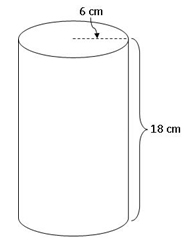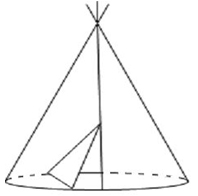
Geometry, Module 4, Lesson 9 - Determining Surface Area of Cones and Cylinders
Determine the approximate total surface area of the cylinder below.

A. 678.58 cm2 |
Incorrect. This is the lateral surface area. You need to include the areas of both bases to determine the total surface area. |
B. 904.78 cm2 |
Correct! |
C. 334.19 cm2 |
Incorrect. To find the total surface area of the cylinder, find the area of the base and multiply it by 2 for 2 bases, and then add the area of the rectangle for the side. |
D. 648.00 cm2 |
Incorrect. To find the total surface area of the cylinder, find the area of the base and multiply it by 2 for 2 bases, and then add the area of the rectangle for the side. |
Rita is preparing chocolate-dipped waffle cones that will be filled with fruit for a wedding reception. The package of chocolate says that each bar of chocolate will cover 80 square inches of surface. The cones that Rita has purchased have a slant height of 3 inches and are 2 inches in diameter. How many bars of chocolate must Rita buy if she plans to dip 100 cones?
A. 24 bars |
Incorrect. We know that the diameter of each cone is 2 inches, so what is the radius of each cone? |
B. 943 bars |
Incorrect. This is the approximate lateral surface area of the cones that Rita will dip in chocolate. Now, divide this area by the amount that is covered by each bar of chocolate. |
C. 12 bars |
Correct! Great job finding the lateral surface area of 100 waffle cones, and then dividing by the 80 square inches that each chocolate bar will cover. |
D. 8 bars |
Incorrect. Find the lateral surface area of one cone, multiply by 100 and divide by 80 in² to find the number of chocolate bars needed. |
Well casing is hollow cylindrical pipe that is placed inside of a well after it is drilled so that water can be pumped up from the bottom of the well and into a tank. A 100-foot length of PVC well casing with a 3 inch radius weighs 330 pounds.

Assume that the thickness of the pipe is not a factor. To the nearest tenth of a pound, about how much does this pipe material weigh per square foot?
A. 2.1 pounds |
Correct! You found the lateral surface area of the pipe, then found the unit rate of the pipe material’s weight per square foot. |
B. 25.2 pounds |
Incorrect. Be sure that your units match (you will need to convert inches to feet or feet to inches before substituting the numbers into the formula for lateral surface area). |
C. 1.1 pounds |
Incorrect. Divide 330 by the lateral area – multiply the height by the circumference of the circle changing the radius to feet first. |
D. 0.02 pounds |
Incorrect. You did all the calculations correctly, but you did not convert square inches into square feet. |
Adrian and his three friends want to build a canvas teepee like the one shown here so that they can camp out during the summer. They want their teepee to have a canvas bottom and to close in the front to keep out insects.

The boys want the floor of the teepee to have a diameter of 12 feet and to be 8 feet high at the top. What is the minimum amount of canvas they must buy in order to be able to build their teepee?
A. 264 square feet |
Incorrect. The given height is the height of the cone-shaped teepee. To determine the lateral surface area of the teepee, you need to use the Pythagorean Theorem to calculate the slant height of the cone. |
B. 114 square feet |
Incorrect. It appears that you found the area of the base, add it to the lateral surface area. |
C. 189 square feet |
Incorrect. You found the lateral surface area of the cone-shaped teepee, but don’t forget to add the area of the canvas floor. |
D. 302 square feet |
Correct! This is the total surface area of the cone-shaped teepee. |